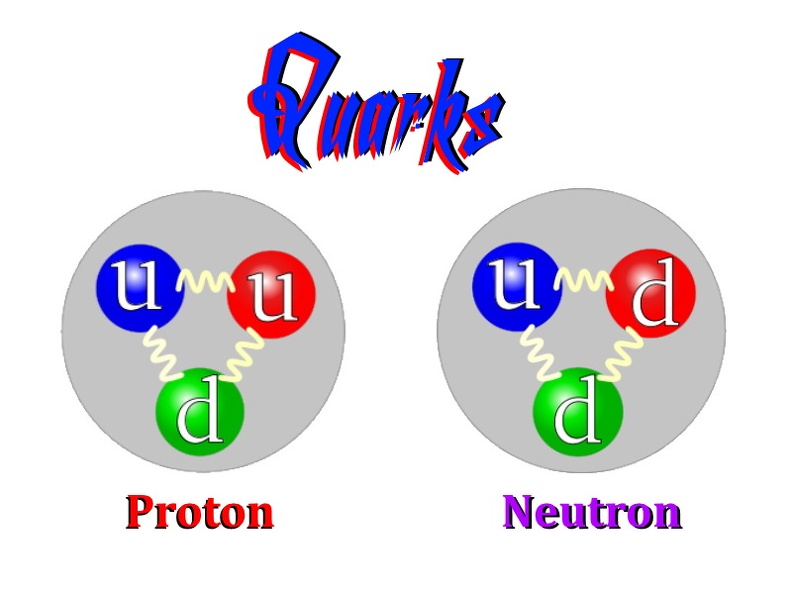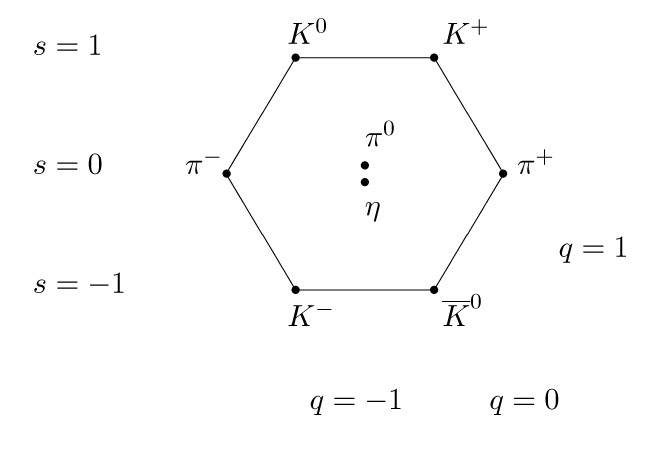Post by 1dave on Apr 7, 2020 8:52:53 GMT -5
The universe is simple - constructed of just 4 items - Energy, Protons, Neutrons, and Electrons.
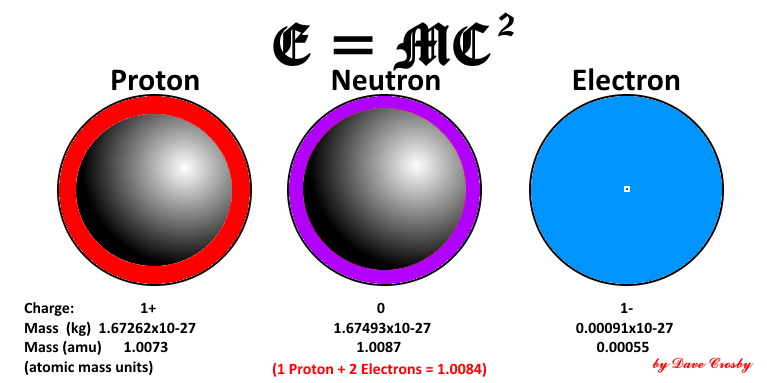
It is estimated that 87% of the physical universe consists of hydrogen atoms, 12% helium atoms, and everything else is just ONE Percent! All the rest of the universe is filled with Gravity and Electromagnetic Fields - Energy. If it were not so there could be no light.
Hydrogen deserves a closer examination. Those atoms consist of a single proton and a single electron. How big are hydrogen atoms? They are very tiny, having a diameter of about one-billionth of a yard or meter! Within those extremely small atoms are even smaller regions called the nucleus. The nucleus has a diameter about 10,000 times smaller than the volume of the atom as a whole.
One analogy is to imagine the atom as the size of the Roman Coliseum. In that gigantic stadium the nucleus would only be the size of a small marble sitting in the center.
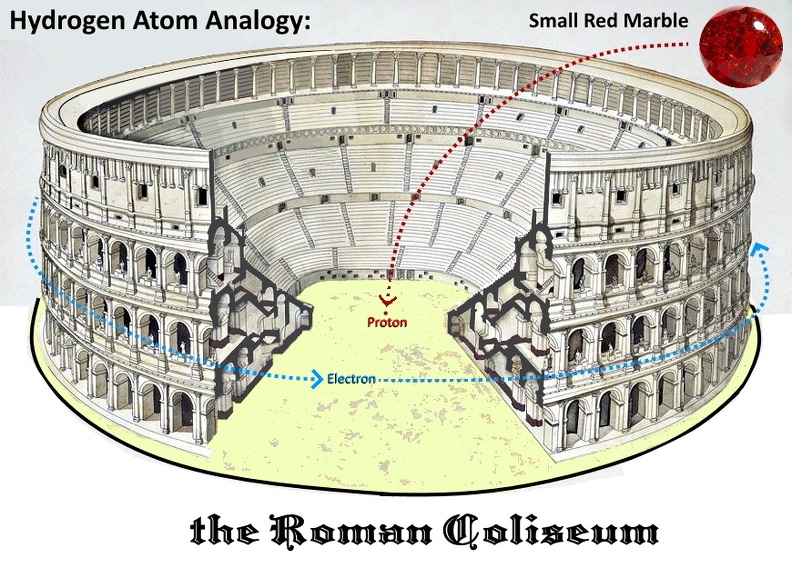
Zipping around the coliseum at about 1400 miles per second, would be the electron, 1,831.454545 times smaller than the nucleus.

So the atom is mostly “empty space” -
Filled with Four Fundamental Forces:
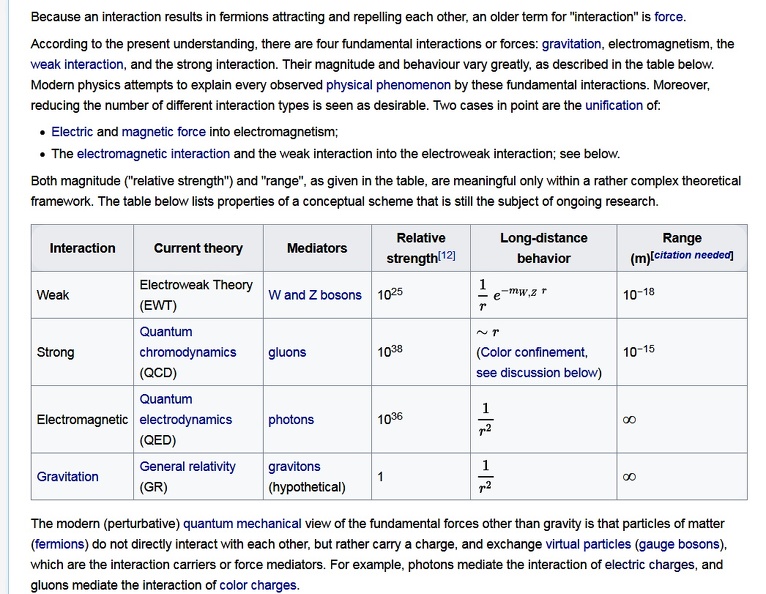
The protons and neutrons contain most of the mass and density of the universe, and are involved in all of the Four Fundamental Forces.
1. Gravity - (range = ∞) the attraction between two objects that have mass or energy. Though gravity holds planets, stars, solar systems and even galaxies together, it turns out to be the weakest of the fundamental forces, especially at the molecular and atomic scales. And at the molecular and atomic levels, gravity has almost no effect relative to the other fundamental forces.
Gravitation:
1. Is the only interaction that acts on all particles having mass, energy and/or momentum.
2. Has an infinite range (with units augmenting each other), like electromagnetism (where units tend to cancel each other out) but unlike strong and weak interaction, cannot be absorbed, transformed, or shielded against.
3. Always attracts and never repels.
Nothing "cancels" gravity, since it is only attractive, unlike electric forces which can be attractive or repulsive. On the other hand, all objects having mass are subject to the gravitational force, which only attracts. Therefore, only gravitation matters on the large-scale structure of the universe.
The long range of gravitation makes it responsible for such large-scale phenomena as the structure of galaxies and black holes and it retards the expansion of the universe. Gravitation also explains astronomical phenomena on more modest scales, such as planetary orbits, as well as everyday experience: objects fall; heavy objects act as if they were glued to the ground, and animals can only jump so high.
2. The strong force - (range = 10 -15m) is the strongest of the four fundamental forces of nature. It's 6 thousand trillion trillion trillion (that’s 39 zeroes after 6!) times stronger than the force of gravity, according to the HyperPhysics website. And that's because it binds the fundamental particles of matter together to form larger particles. It holds together the quarks that make up protons and neutrons, and part of the strong force also keeps the protons and neutrons of an atom's nucleus together. Much like the weak force, the strong force operates only when subatomic particles are extremely close to one another. They have to be somewhere within 10^-15 meters from each other, or roughly within the diameter of a proton, according to the HyperPhysics website.
The strong force is odd, though, because unlike any of the other fundamental forces, it gets weaker as subatomic particles move closer together. It actually reaches maximum strength when the particles are farthest away from each other, according to Fermilab. Once within range, massless charged bosons called gluons transmit the strong force between quarks and keep them "glued" together. A tiny fraction of the strong force called the residual strong force acts between protons and neutrons. Protons in the nucleus repel one another because of their similar charge, but the residual strong force can overcome this repulsion, so the particles stay bound in an atom's nucleus.
3. The weak force - (range = 10 -18m) is responsible for particle decay. In the weak force, the bosons are charged particles called W and Z bosons. When subatomic particles such as protons, neutrons and electrons come within 10^-18 meters, or 0.1% of the diameter of a proton, of one another, they can exchange these bosons. As a result, the subatomic particles decay into new particles, according to Georgia State University's HyperPhysics website. The weak force is critical for the nuclear fusion reactions that power the sun
(cool14) The Fourth Force is mainly the domain of the tiny electron.
4. Electromagnetism - (range = ∞) acts between charged particles, like negatively charged electrons and positively charged protons. Opposite charges attract one another, while like charges repel. The greater the charge, the greater the force. And much like gravity, this force can be felt from an infinite distance (albeit the force would be very, very small at that distance).
As its name indicates, the electromagnetic force consists of two parts: the electric force and the magnetic force.
The electric component acts between charged particles whether they're moving or stationary, creating a field by which the charges can influence each other. But once set into motion, those charged particles begin to display the second component, the magnetic force. The particles create a magnetic field around them as they move. So when electrons zoom through a wire to charge your computer or phone or turn on your TV, for example, the wire becomes magnetic.
Electromagnetic forces are transferred between charged particles through the exchange of massless, force-carrying bosons called photons, which are also the particle components of light. The force-carrying photons that swap between charged particles, however, are a different manifestation of photons. They are virtual and undetectable, even though they are technically the same particles as the real and detectable version, according to the University of Tennessee, Knoxville.
The electromagnetic force is responsible for some of the most commonly experienced phenomena: friction, elasticity, the normal force and the force holding solids together in a given shape. It's even responsible for the drag that birds, planes and even Superman experience while flying. These actions can occur because of charged (or neutralized) particles interacting with one another. The normal force that keeps a book on top of a table (instead of gravity pulling the book through to the ground), for example, is a consequence of electrons in the table's atoms repelling electrons in the book's atoms.
The force that keeps a book on top of a table (instead of gravity pulling the book through to the ground), is a consequence of the electromagnetic force: Electrons in the table's atoms repel electrons in the book's atoms.
- Two Force particles, called gauge bosons — force carriers or messenger particles of underlying fields—interact with Three matter particles, called fermions.
Everyday matter is composed of atoms made with three fermion types: up-quarks and down-quarks constituting the nucleus, and electrons orbiting the nucleus.
Atoms interact, form molecules, and manifest further properties through electromagnetic interactions among their electrons absorbing and emitting photons, the electromagnetic field's force carrier, which if unimpeded traverse potentially infinite distance.
Electromagnetism's QFT is quantum electrodynamics (QED).


The modern (perturbative) quantum mechanical view of the fundamental forces other than gravity is that particles of matter (fermions) do not directly interact with each other, but rather carry a charge, and exchange virtual particles (gauge bosons), which are the interaction carriers or force mediators.
For example, photons mediate the interaction of electric charges, and gluons mediate the interaction of color charges.
“Color charge is a property of quarks and gluons that is related to the particles' strong interactions in the theory of quantum chromodynamics. The "color charge" of quarks and gluons is completely unrelated to the everyday meaning of color.”- Wikipedia.

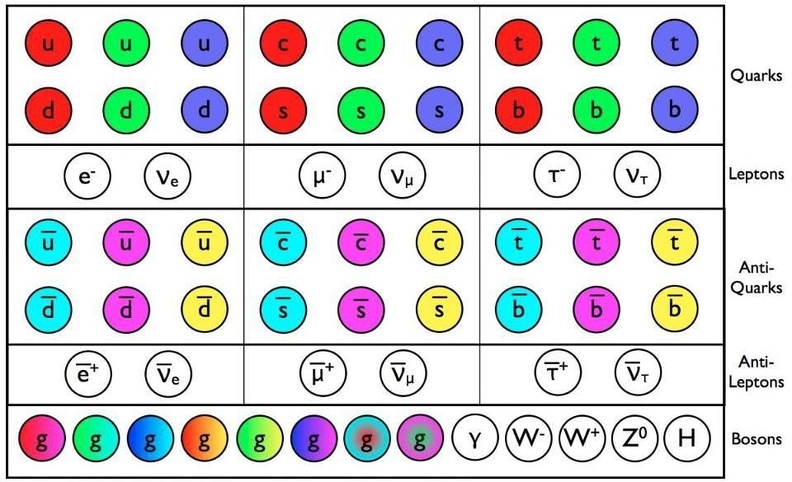
Complicated? Perhaps our imaginations have led us astray.

Contemplate that bottom RED STATEMENT!
It is estimated that 87% of the physical universe consists of hydrogen atoms, 12% helium atoms, and everything else is just ONE Percent! All the rest of the universe is filled with Gravity and Electromagnetic Fields - Energy. If it were not so there could be no light.
Hydrogen deserves a closer examination. Those atoms consist of a single proton and a single electron. How big are hydrogen atoms? They are very tiny, having a diameter of about one-billionth of a yard or meter! Within those extremely small atoms are even smaller regions called the nucleus. The nucleus has a diameter about 10,000 times smaller than the volume of the atom as a whole.
One analogy is to imagine the atom as the size of the Roman Coliseum. In that gigantic stadium the nucleus would only be the size of a small marble sitting in the center.

Zipping around the coliseum at about 1400 miles per second, would be the electron, 1,831.454545 times smaller than the nucleus.
BTW, those outer electrons - "valence electrons," in larger atoms, - are not as securely bound as might be imagined. They can slide around from place to place in a phenomenon known as . . .
"TRIBOELECTRIC" - TRIBO being Greek for "rub," and ELECTRIC being Greek for amber.

So the atom is mostly “empty space” -
Filled with Four Fundamental Forces:

The protons and neutrons contain most of the mass and density of the universe, and are involved in all of the Four Fundamental Forces.
1. Gravity - (range = ∞) the attraction between two objects that have mass or energy. Though gravity holds planets, stars, solar systems and even galaxies together, it turns out to be the weakest of the fundamental forces, especially at the molecular and atomic scales. And at the molecular and atomic levels, gravity has almost no effect relative to the other fundamental forces.
Gravitation:
1. Is the only interaction that acts on all particles having mass, energy and/or momentum.
2. Has an infinite range (with units augmenting each other), like electromagnetism (where units tend to cancel each other out) but unlike strong and weak interaction, cannot be absorbed, transformed, or shielded against.
3. Always attracts and never repels.
Nothing "cancels" gravity, since it is only attractive, unlike electric forces which can be attractive or repulsive. On the other hand, all objects having mass are subject to the gravitational force, which only attracts. Therefore, only gravitation matters on the large-scale structure of the universe.
The long range of gravitation makes it responsible for such large-scale phenomena as the structure of galaxies and black holes and it retards the expansion of the universe. Gravitation also explains astronomical phenomena on more modest scales, such as planetary orbits, as well as everyday experience: objects fall; heavy objects act as if they were glued to the ground, and animals can only jump so high.
2. The strong force - (range = 10 -15m) is the strongest of the four fundamental forces of nature. It's 6 thousand trillion trillion trillion (that’s 39 zeroes after 6!) times stronger than the force of gravity, according to the HyperPhysics website. And that's because it binds the fundamental particles of matter together to form larger particles. It holds together the quarks that make up protons and neutrons, and part of the strong force also keeps the protons and neutrons of an atom's nucleus together. Much like the weak force, the strong force operates only when subatomic particles are extremely close to one another. They have to be somewhere within 10^-15 meters from each other, or roughly within the diameter of a proton, according to the HyperPhysics website.
The strong force is odd, though, because unlike any of the other fundamental forces, it gets weaker as subatomic particles move closer together. It actually reaches maximum strength when the particles are farthest away from each other, according to Fermilab. Once within range, massless charged bosons called gluons transmit the strong force between quarks and keep them "glued" together. A tiny fraction of the strong force called the residual strong force acts between protons and neutrons. Protons in the nucleus repel one another because of their similar charge, but the residual strong force can overcome this repulsion, so the particles stay bound in an atom's nucleus.
3. The weak force - (range = 10 -18m) is responsible for particle decay. In the weak force, the bosons are charged particles called W and Z bosons. When subatomic particles such as protons, neutrons and electrons come within 10^-18 meters, or 0.1% of the diameter of a proton, of one another, they can exchange these bosons. As a result, the subatomic particles decay into new particles, according to Georgia State University's HyperPhysics website. The weak force is critical for the nuclear fusion reactions that power the sun
(cool14) The Fourth Force is mainly the domain of the tiny electron.
4. Electromagnetism - (range = ∞) acts between charged particles, like negatively charged electrons and positively charged protons. Opposite charges attract one another, while like charges repel. The greater the charge, the greater the force. And much like gravity, this force can be felt from an infinite distance (albeit the force would be very, very small at that distance).
As its name indicates, the electromagnetic force consists of two parts: the electric force and the magnetic force.
The electric component acts between charged particles whether they're moving or stationary, creating a field by which the charges can influence each other. But once set into motion, those charged particles begin to display the second component, the magnetic force. The particles create a magnetic field around them as they move. So when electrons zoom through a wire to charge your computer or phone or turn on your TV, for example, the wire becomes magnetic.
Electromagnetic forces are transferred between charged particles through the exchange of massless, force-carrying bosons called photons, which are also the particle components of light. The force-carrying photons that swap between charged particles, however, are a different manifestation of photons. They are virtual and undetectable, even though they are technically the same particles as the real and detectable version, according to the University of Tennessee, Knoxville.
The electromagnetic force is responsible for some of the most commonly experienced phenomena: friction, elasticity, the normal force and the force holding solids together in a given shape. It's even responsible for the drag that birds, planes and even Superman experience while flying. These actions can occur because of charged (or neutralized) particles interacting with one another. The normal force that keeps a book on top of a table (instead of gravity pulling the book through to the ground), for example, is a consequence of electrons in the table's atoms repelling electrons in the book's atoms.
The force that keeps a book on top of a table (instead of gravity pulling the book through to the ground), is a consequence of the electromagnetic force: Electrons in the table's atoms repel electrons in the book's atoms.
Quantum Field Theory (QFT)
- Two Force particles, called gauge bosons — force carriers or messenger particles of underlying fields—interact with Three matter particles, called fermions.
Everyday matter is composed of atoms made with three fermion types: up-quarks and down-quarks constituting the nucleus, and electrons orbiting the nucleus.
Atoms interact, form molecules, and manifest further properties through electromagnetic interactions among their electrons absorbing and emitting photons, the electromagnetic field's force carrier, which if unimpeded traverse potentially infinite distance.
Electromagnetism's QFT is quantum electrodynamics (QED).


The modern (perturbative) quantum mechanical view of the fundamental forces other than gravity is that particles of matter (fermions) do not directly interact with each other, but rather carry a charge, and exchange virtual particles (gauge bosons), which are the interaction carriers or force mediators.
For example, photons mediate the interaction of electric charges, and gluons mediate the interaction of color charges.
“Color charge is a property of quarks and gluons that is related to the particles' strong interactions in the theory of quantum chromodynamics. The "color charge" of quarks and gluons is completely unrelated to the everyday meaning of color.”- Wikipedia.


Complicated? Perhaps our imaginations have led us astray.







